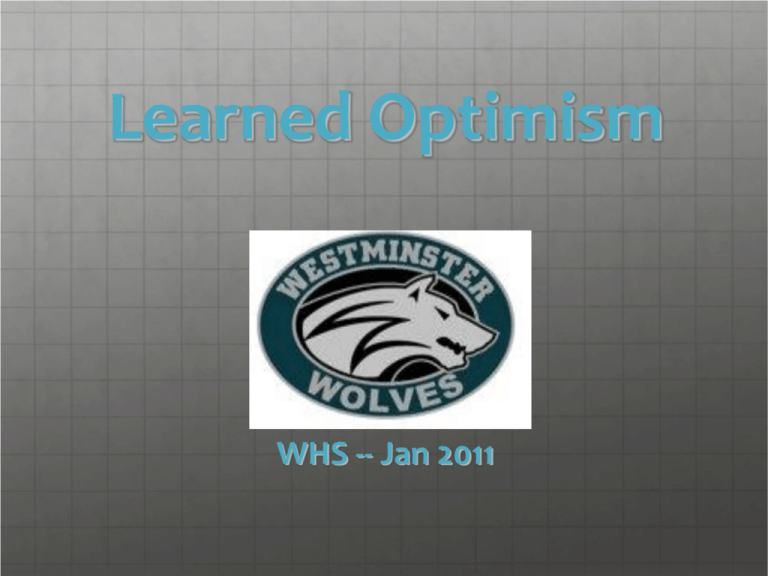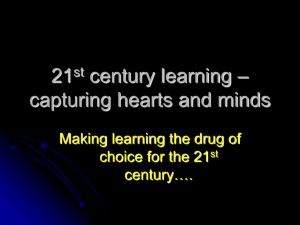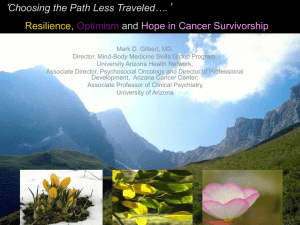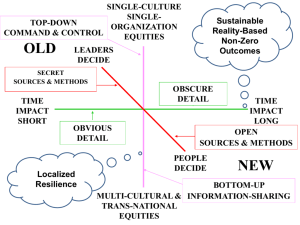Learned Optimism
advertisement

Learned Optimism WHS -- Jan 2011 This PowerPoint is set up in 2 parts: #1) review resilience & intrinsic motivation #2) learn how to reframe negative thoughts & build learned optimism for success in TEST TAKING. (a skill that can be transferred to life in general) Lessons from a Skateboard Park Intrinsic motivation & engagement http://commons.wikimedia.org/wiki/File:Skateboarder_in_the_air.jpg Why will someone practice and fall, practice and fall, practice and fall over and over again? Review what you already know about intrinsic motivation Next, look at following slide to see what we all need to be engaged and intrinsically motivated……? Everyone needs: Sense of security Sense of belonging Sense of purpose Sense of personal competence and pride Sense of trust Sense of making real choices and decisions Sense of self discipline and self control Sense of encouragement support and rewards Sense of responsibility Sense of accepting mistakes and failure Sense of contribution Sense of family self esteem Discussion: How can we take the lessons we learned in the Skateboard Park about intrinsic motivation & engagement and adapt them into the classroom environment?? http://commons.wikimedia.org/wiki/File:Sonnenaufgang.jpg Characteristics of Resilient Student Recognize and manage own feelings/understand feelings of others Have a sense of independence and self worth Form and maintain positive mutually respectful relationships with others Ability to solve problems and make informed decisions Have a sense of purpose for future/ HOPE Advantageous Skills in Successful Student? Intrinsic motivation/ self Restraint/delayed discipline gratification Self respect/esteem/personal power Integrity/honesty/spiritu ality Humor Justice/tolerance Self/acceptance/love Resistance skills/adaptability Compassion, kindness, caring/insight Peaceful conflict resolution Social skills/manners Sense of purpose/positive future Creativity/initiative edia.org/wiki/File:Golly_Farm_in_the_hamlet_of_Golly_- Now …A look at the road to Learned Optimism [[File:Greenbrowneye.jpg|thumb|Greenbrowneye]] Instead of worrying about what people say of you, why not spend time trying to accomplish something they will admire. - Dale Carnegie 2009 Twitter Take a look at how pessimists and optimists approach a problem…… Explanatory Style Permanence (pessimistic) Temporary (optimistic) Universal (pessimistic) Specific (optimistic) I’ll never lose weight, diets never work! Diets don’t work when you eat in restaurants. All teachers are unfair. Professor Jones is unfair. I’m Repulsive. You always nag. You nag when I don’t clean my room. Your boss is a //!!@#%% Your boss is in a bad mood. I’m repulsive to him today. With my rumpled clothes and messy hair. Books are useless. This book is useless. You never talk to You haven’t me! talked to me much lately. Think about the info below- you will be using this technique in a moment to think about test taking…… hopeless hopeful I’m stupid! I was sleep deprived when I did that. All men are tyrants! My boyfriend was in a bad mood for a good reason. Chances are 9/10 that this lump is cancer. Chances are 9/10 that this lump is nothing. Pen left uncapped ……What doesn’t kill us makes us stronger How long does this last? Who’s responsible? How big is this? Optimistic point of view A few minutes I am Frustrating, not important Pessimistic point of view At least all day - if not longer Anyone but me -I got distracted 8 on a scale of 1 to 10 Learn to Reframe your thoughts: 1) recognize automatic thoughts 2) dispute (disagree with) automatic thoughts 3)make different explanation 4) distract yourself from depressing thoughts 5) learn to recognize and question depressive assumptions Practice What are some scenarios in your own life where you loose track of reality? 1) The teacher blamed me for something I didn't do.. Now reframe. 2) Juan ignored me in the hall, he must hate me….. Reframe 3) what else?............... dia.org/wikipedia/commons/e/e8/Mavrica.jpg Finals/CSAP/Scantron How can you apply learned optimism and techniques about reframing to help you be prepared and positive for CSAP? look at the following scenarios and reframe (first one is done for you): (you think) I am totally lost… this is a literacy question about figurative language…..what the #$%&&!! Does this question mean? 1) Use hyperbole to explain how big the fish was that you caught recently. (you think) Aohh wait… I have a good memory and remember my teacher telling me to look at word parts …hmm… hyper- I know it means lots of movement someone who can’t sit still- --exaggeratedI think I will exaggerate the size of my fish and say……….. It was as big as a mountain, Pikes Peak! Now you do the reframing: 1) I can’t believe I only have 15 minutes left- I am so stupid and slow- I will never finish! reframe 2) I am certain I missed all 5 of the first questions--- this is a mess- I will never get a proficient grade. reframe 3) Other possible scenarios? If it’s going to be – it’s up to me….. Put the pieces together http://psychologicalresolutions.co.nz/uploads/i mages/resilience.jpg http://commons.wikimedia.org/wiki/File:Working_Together_Teamwork_Puzzle_Co ncept.jpg -BE Happy -BE Resilient -BE Optimistic http://commons.wikimedia.org/wiki/File:Felicidade_A_very_happy_boy.jp g http://commons.wikimedia.org/wiki/File:Happy_Chihuahua.jpg http://www.wpclipart.com/animals/R/rabbit/Brown_Hare.png.html IMAGINE ttp://www.new-york-gallery.com/photos/442-imagine-a-tribute-to-john-lennon.jpg References Brooks, R. & Goldstein,S. Raising Resilient Children. New York: McGraw Hill, 2001. Goleman, D. Emotional Intelligence. New York: Bantam Books, 1995. Goleman, D. Social Intelligence. New York: Bantam Books, 2006 Kagan, S. & Kagan, M. Multiple Intelligences. The Complete Book. San Clemente, CA: Kagan Publishing, 1995. Kagan, S. , Kagan Structures for Emotional Intelligence. Reivitch, K. & Shatte, A. The Resilience Factor. New York: Broadway Books, 2001. Seligman, M. Learned Optimism. New York: Free Press, 1990. Segal, J. Raising Your Emotional Intelligence. New York: Henry Holy & CO., 1997. Warschaw, T. & Barlow, D. Resiliency: How to Bounce Back Faster, Stronger, Smarter. New York: Master Media Ltd. 1995. References Brooks, R. & Goldstein, S. Raising Resilient Children. New York: McGraw Hill, 2001. Brooks, R & Goldstein, S. The Power of Resilience. New York: McGraw Hill, 2003. Goleman, D. Emotional Intelligence. New York: Bantam Books, 1995. Goleman, D. Social Intelligence. New York: Bantam Books, 2006 Kagan, S. & Kagan, M. Multiple Intelligences. The Complete Book. San Clemente, CA: Kagan Publishing, 1995. Kagan, S. (2001) Structures for Emotional Intelligence. Retrieved October 9, 2008 from http://www.Kagononline.com/KaganClub/Freea/ASK14.htmlrticles Reivitch, K. & Shatte, A. The Resilience Factor. New York: Broadway Books, 2001. Seligman, M. Learned Optimism. New York: Free Press, 1990. Segal, J. Raising Your Emotional Intelligence. New York: Henry Holy & CO., 1997. Warschaw, T. & Barlow, D. Resiliency: How to Bounce Back Faster, Stronger, Smarter. New York: Master Media Ltd. 1995. Merlevede, P. Bridoux, D., Vandamme, R. Seven Steps to Emotional Intelligence. Wales: Crown House Publishing, LTD, 1997. Douglas, M. Making a Habit of Success. New York: Galahad Books. 1994. Ryan, M. J., (2009 April) Secrets of Super Resilient People . Health , 109. Edutopia (2009) Emotional Intelligence: the Missing Piece. Retrieved March 25, 2009 from http://www.edutopia.org/print/680 Emotional Intelligence in Schools. Retrieved March22, 2009 from http://www.connected.org/learn/school.html Todd, D. (2008, April 1) Students Trained to Use Emotional and Social Intelligence. Retrieved March 25, 2009 from http:// www2.canada.com/components Noble, T. Helping Kids to Bounce Back Through a Curriculum-Based Approach to Teaching Resilience . Australian Catholic University, Australia. Winfield, L. (1994) Urban Education Homograph Series. Developing Resilience in Urban Youth. NCREL Monograph. Retrieved March 22, 2009 from http://www.ncrel.org/sdrs/areas/issues/educators/leadership Wolin,S. & Wolin, S. The Resilient Self. Minnesota: Search Institute. 1997. Gotberg, E. (1999). Countering Depression with the Five Building Blocks of Resilience. Reaching Today’s Youth 4 (1, Fall): 66-72. Marano, H. (2007). Psychology Today. Retrieved March 22, 2009 from http:// www.psychologytoday.com/articles/pto-20030527-000009.html McCarthy, L. (1998. ADDitudeMag.com Teaching Resilience to ADHD Children: Advice for Parents. Retrieved March 22, 2009 from http://additudemag.com/adhd/article/print/2525.html Goh, K. ( 2008). Teaching Assertiveness and Resilience to our Children. Ezine articels. Retrieved March 22, 2009 from http.//ezinearticles.com/?Teaching – Assertiveness-and-Resilience-to-our-=Children &id=1647290&0pt=print American Academy of Pediatrics (200). Components of High Self Esteem. Retrieved March22,2009 from http://www.medem.com/medlib/print/ZZZLKS96W7C








